Business Management Improvement: The Future of USDA Foods
From
2015-2017, USDA and key stakeholders are reviewing the USDA Foods program's end-to-end processes – from
ordering to delivery to inventory management – with the goal of increasing
efficiency and improving the program for all stakeholders. This exciting initiative is now moving on to its next phase! The Business Management Improvement (BMI)
project will soon begin developing a Business Case for the changes identified
during the “To Be” phase, with an Implementation Plan to follow in early 2017.
 The “To Be”
phase has focused on the future of USDA Foods. BMI stakeholders collaborated in a series of workshops in
June and July to design improved business processes and to identify related
policy, procedures, regulations, and organizational structures. Proposed
changes considered the pain points, system gaps, industry references, and
benchmarks identified in the “As Is” phase.
BMI collaborators
met August 16-18 in an Accelerated Solutions Environment (ASE) workshop to discuss the “Big Ideas” generated from the workshops and
validate vision outcomes. On September 23, USDA held a
follow-up meeting with Recipient Agencies to discuss the “To Be” outcomes from the ASE workshop. Additional briefings will be
provided to USDA stakeholders and staff over the next few months.
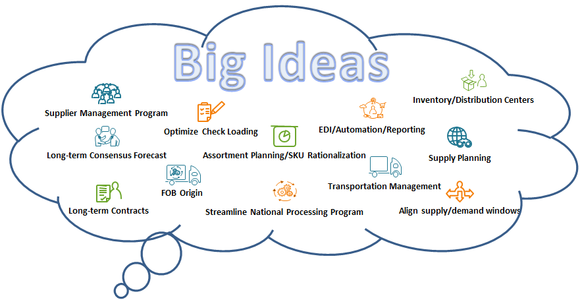 The BMI is a significant milestone in the evolution of
the USDA Foods program providing stakeholders with an opportunity to provide
their input to process improvements. For related news and additional
information, visit the BMI webpage. Any questions or
comments about the BMI may be directed to CP-BPRINFO@ams.usda.gov.
North Carolina Visits USDA Headquarters for Training and Taste Testing
Bob Sitton, Vicky Cox, Gary Gay, Ted Fogleman, David Usher, Melissa Ayscue, and Tysha Sherard from the North Carolina Department of Agriculture & Consumer Services sample USDA Foods in the USDA test kitchen.
Seven staffers of the North Carolina Department of Agriculture and Consumer Services, Food Distribution Division took an opportunity to meet with USDA staff in Arlington, Virginia, on September 13-14, 2016.
We received great presentations followed
with questions and discussions. It was nice to have the Branch Chiefs report on their respective sections and the specialists speak to their responsibilities. This proved to be timed perfectly
as we had with us several new staffers, which offered a terrific opportunity
for them as well as some of the “more seasoned” staff to sit around the table
and talk and ask questions on any topic of all of the USDA Foods Programs.
On the second day, we traveled to the USDA South Building
in Washington, DC, for meetings. Here they provided us the wonderful opportunity to see and taste
many of the new products for this school year, and some products under
consideration for next school year. It is amazing the amount of consideration
that is given to new products and to see what an involved process it is to
bring a new product on board to offer to schools.
This was a very informative trip, the only thing missing was
the red carpet as USDA made us all feel very welcome. The time was well spent,
it was very informative and the information gleaned will be passed
along in our trainings to local agencies in our State.
Thanks to all the USDA staff for taking the time for
our meetings, and the taste testing was terrific!
Gary Gay, Director
NCDA&CS Food Distribution Division
Spirit Lake Youth Nutrition Camps Bring Valuable Lessons to Kids
The Spirit Lake Sioux Tribe of Fort Totten, North Dakota, hosted 41 boys and girls ages 8-18 in an interactive, informative, and (most importantly) fun Nutrition Youth Camp in July. The two-day camp was a cooperative effort between Spirit Lake Sioux Tribe and United Tribes Technical College funded by the Food Distribution Program Nutrition Education grant.
 The activity-filled days included
food safety, nutrition, and living green lesson themes. One unique activity
connected food with tradition by matching photos of food with the English name
and its Lakota name. Kids grabbed a photo, said each name while matching it to
the MyPlate food group the food item belonged to – all while running to
different colored hula hoops which represented those different MyPlate food
groups. Another meaningful activity included a Pledge to Mother Earth. A Tribal
elder shared with the kids stories
about foods she ate in connection with her culture and compared those to
unhealthy foods many kids eat today. She helped the kids make a link between
their lifestyles and Mother Earth. The kids used her stories as inspiration to
make their own Pledge to Mother Earth. They wrote down their own pledges and
displayed them in the lobby of Spirit Lake’s Food Distribution Program on Indian Reservations (FDPIR) service center. Committing
to planting a garden and using a refillable water bottle are examples of the
inspired pledges the kids made. FDPIR Director Mary Greene Trottier said this activity was one
of the most popular and she still enjoys reading the pledges as she walks by
the display in her building.
Spirit
Lake Sioux Tribe’s 2016 Youth Nutrition Camp is an example of the impact an
FDPIR program can have on its community. It was so successful they are
offering a second camp in December while kids are on winter break.
|
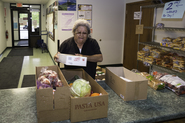 How Much Do You Know About FDPIR?
Are You Interested in Finding Out More?
Do you have an interest in learning about the characteristics of FDPIR participants? Would you like to learn about differences in warehouse operation and distribution models? Or the role nutrition and health education plays at local sites on Indian reservations? Are you curious about the foods offered in the food package? If any of these areas interest you, then check out the recently published Study of the Food Distribution Program on Indian Reservations. This national characteristic study captures the most current program and participant information about FDPIR such as:
- Nearly half of all households served by FDPIR are a one-person household.
- Twenty-nine percent of households participating in FDPIR have elderly members only.
- Over 90% of survey respondents are satisfied
with the variety of food, the freshness, the quality, the nutritional value,
and the taste and visual appeal.
- An estimated 52% of research respondents that participated in a nutrition education activity indicated they made changes to their cooking or eating.
- And more!
|
Celebrating National School Lunch Week
In 1962 President John F. Kennedy created National
School Lunch Week, a
weeklong event celebrating the school lunch program. Many districts decorate their cafeterias and
have fun events planned. This year’s
celebration was October 10-14 and the theme was “Show Your Spirit.” The goal is to increase student participation
while teaching them the benefits of consuming wholesome school
lunches, to spread the message regarding the benefits of the school lunch to
parents, and to connect with teachers and administrators. There is always time to celebrate the
National School Lunch Program even if you missed this event. Plan your own
activity that fits with your district’s schedule!
USDA offers a variety of resources and ideas for championing school lunch. Check out these posts on the USDA blog from National School Lunch Week 2016!

By: Christopher Bernstein, Food Safety Education Staff, Food Safety and Inspection Service, USDA
How many times have you gone into your pantry or refrigerator, only to find that what you were going to use in your meal was spoiled? The USDA, Cornell University and the Food Marketing Institute would like to help you avoid that problem in the future with our new application, the FoodKeeper.
Every year, billions of pounds of good food go to waste in the U.S. because home cooks are not sure of the quality or safety of items. USDA estimates that 21% of the available food in the U.S. goes uneaten at the consumer level. In total, 36 pounds of food per person is wasted each month at the retail and consumer levels! Read more
|
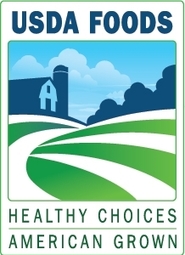 New Food Distribution Webinars and Training Page
Are you interested in viewing webinars you missed, or brushing up on key topics related to your USDA Foods program? The new Food Distribution Webinars and Training page contains a variety of useful resources - YouTube videos, online courses, and power point presentations - organized into these categories:
- USDA Foods Basics (All Programs)
- Child Nutrition Programs (NSLP, CACFP)
- USDA Foods Processing (NSLP)
- Institute of Child Nutrition Online Training
- Household Programs (FDPIR, CSFP, TEFAP)
- Web Based Supply Chain Management
As you can see, there's something for everyone! Check out these new resources today.
|
New Infographic: Food Safety in Schools
The Food and Nutrition Service (FNS) Office of Food Safety website provides food
safety education and training resources for Child Nutrition Program operators,
including school nutrition professionals. Schools are doing a great job of ensuring
kids receive safe meals. When
foodborne outbreaks do occur in schools, illnesses are most often associated
with norovirus. This
infographic highlights three key practices that can help prevent norovirus in
schools.
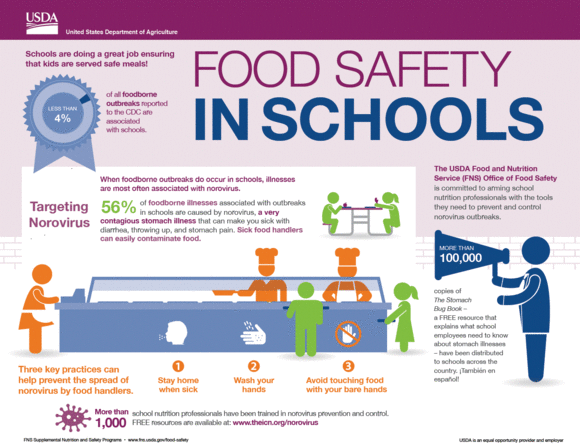
Hunger in America Exhibit
In September, Feeding America presented “Hunger in
America: a Congressional Exhibition” at the Rayburn House Office Building in
Washington, DC. USDA and congressional
staff were invited to view the exhibition, which portrayed the voices and faces
of those impacted by hunger. Statistics
on food security and portraits of food assistance recipients from all 50 states
were presented. Many recipients noted
the importance of USDA’s food assistance in their daily lives. For example, one of the individuals
photographed noted that without the Commodity Supplemental Food Program (CSFP),
he would have to choose between buying food and paying for medication. A family from Alaska turned to the
Supplemental Nutrition Assistance Program (SNAP), the Summer Food Service
Program (SFSP), and The Emergency Food Assistance Program (TEFAP) when obtaining
food became difficult, partly due to walrus no longer being available in
sufficient quantities to feed their community.
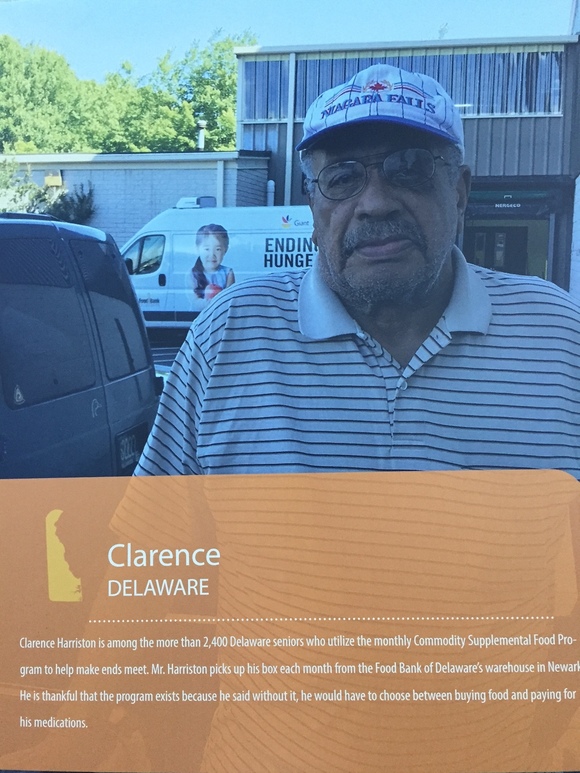
A MyPlate Food Pantry in Colorado
The Action Center in Lakewood, Colorado, distributes food
through both The Emergency Food Assistance Program (TEFAP) and the Commodity
Supplemental Food Program (CSFP), and its emphasis on nutrition and
self-sufficiency has inspired creative partnerships to better serve those in
need. In September, USDA National Office and Regional Office staff, along with
the Colorado Department of Human Services, had the opportunity to visit The
Action Center’s new facilities, which opened in April 2015, and see first-hand
how USDA Foods support this organization’s mission.
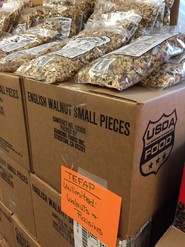 MyPlate is now the basis for the grocery checklist that guides clients through a self-service shopping area organized and color-coded to match the MyPlate food groups of protein, dairy, vegetables, fruits, and grains. TEFAP-eligible clients receive a box of USDA Foods and then select from other donated foods to end up with five days’ worth of food. When bonus items are offered through TEFAP – pinto beans, raisins, and walnuts were available during USDA’s tour – eligible clients may take home as many portions as they can use. In years past, the mix of food that clients received was about 70 percent canned goods and 30 percent fresh vegetables, fruits, meat, and dairy, but The Action Center decided to reverse these proportions to offer more fresh options in support of MyPlate. A partnership with Whole Foods, Trader Joe’s, and Sprouts Farmers Market grocery stores, through a coop with two other local feeding organizations, allows The Action Center to receive 100,000-150,000 pounds of food, including a bounty of fresh produce, each month.
In living out its motto, “pathways to self-sufficiency,” The Action Center connects clients to other social services and runs an extensive volunteer program. An average of 80 volunteers daily assist with client intake and serve as case managers, client advocates, and personal grocery shoppers for the average of 110 people who pass through The Action Center’s doors each day. In addition to food, the organization seeks to meet basic needs of clothing and household goods ranging from silverware to sheets, the latter often donated by a nearby hotel. The Action Center is a truly multi-faceted organization serving its community.
|

State Distributing
Agencies (SDAs), Indian Tribal Organizations (ITOs), and Recipient Agencies
(RAs) must follow general standards and procedures in receiving shipments of
USDA Foods, including USDA Foods received at each delivery location in a
split shipment. The SDA/ITO/RA is responsible for ensuring that each
truckload of USDA Foods received is inspected prior to being unloaded and as it
is being unloaded to determine the overall condition of the USDA Foods and the
number of units in the shipment, and to ensure accuracy of receipt. This helps
to avoid problems later. At the time of delivery and before the truck
leaves, check the following:
- Verify that temperatures for refrigerated and
frozen products are appropriate to assure that the foods are in good condition.
-
Confirm that the quantity
of the product received matches the quantity on the bill of lading (BOL). A
more careful count must be conducted as the shipment is unloaded and prior to
the vendor departing. Indicate any shortages or overages in the shipment on the
BOL.
- Examine the quality of the product;
inspect for damage or infestation.
- Check the condition of the packaging and
containers.
- Confirm that security seal is intact and
that seal number matches number on the BOL.
- Document any issues on the BOL, prior to
signature, and take photos.
Training staff on how to properly receive USDA Foods is important. Also, ensure that sufficient time is
taken to walk around pallets, count cases, open cases, and, if needed, open
internal packaging to check product. Take action immediately if product does
not meet specifications. Vendors have a contractual obligation to deliver food
in a safe and acceptable manner. To file a complaint, visit USDA Foods
Feedback.
Instruction for
receiving shipments of USDA Foods:
USDA
FNS Instruction 709-5, Rev 2, Shipment and Receipt of USDA Foods
The Complaint Team is
available Monday-Friday, 6:00 a.m. – 5:00 p.m. Eastern Time. Email USDAFoodsComplaints@fns.usda.gov
or call the USDA Foods Complaint Hotline at 800-446-6991.
|
Self-Service Tools for eAuthentication
The service
desk teams for WBSCM (Web-Based Supply Chain Management) and FFAVORS (Fresh Fruits and Vegetables Order Receipt System) cannot recover or update user login
credentials. These are maintained in a separate system called eAuthentication. To
recover forgotten information, self-service tools are available from the login
screen via the I forgot my User ID |
Password links.
To
recover forgotten User ID(s), click on User
ID. After entering your information, you will receive a system-generated
message listing any User ID(s) linked to this email.
To reset
your Password, click on Password.
You will be prompted to enter your User ID and answer the security questions
you previously set up for your eAuthentication profile. After confirming your
identity, you will be prompted to enter a new password. This action will also
unlock your eAuthentication account if you had entered the wrong password too
many times. Note: The Change
my Password link can be used to update your account only if you know your
current password.
For your
convenience, a shortcut to the password reset tool is also provided on the
webpages for WBSCM
and FFAVORS:
 To review
and maintain your eAuthentication customer profile, select Update
your account from the Quick Links.
Then, select Home to expand the Tasks section. You can update your
contact information, security questions, and/or password from this menu. It is
not possible to edit your login ID or name via self-service.
If you are
unable to use these self-service tools or need further assistance with recovering
or updating your eAuthentication account information, please contact the
eAuthentication Service Desk at 1-800-457-3642, option 1.
WBSCM News and Resources
WBSCM instructions, guidance, and general information are
available to help users work proficiently. These materials are regularly updated
to correspond to best practices, application enhancements, and system requirements.
FNS Website: The WBSCM
Information webpage provides supplemental information for domestic
customers and FNS support staff. Questions about user access and common issues
are addressed in WBSCM
FAQs & Tips. Technical resources are available for system
requirements and settings and data
upload/download. Recent news, reminders, and recommended solutions to
common problems are shared in a quarterly newsletter.
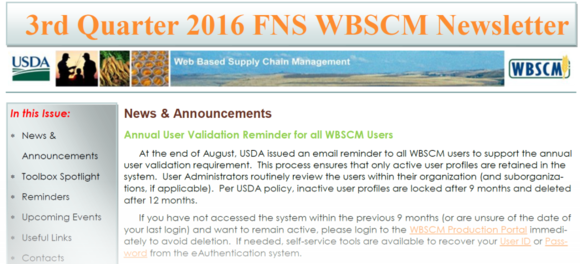 Forum: When
logged in, users can view one or
more forum(s), depending on their role. These are used to announce new software
releases, system outages, upcoming deadlines, and other news. Within WBSCM,
navigate to Home -> News and Alerts. To receive email
notifications when new items are posted, users can “watch”
a forum, thread, or user.

Training Materials: The WBSCM document library contains the
following resources:
-
Course Materials – overview by user roles or
business functions
-
Job Aids – supplemental information and
quick references
-
Work Instructions – step-by-step description of
common transactions
-
Release Notes – summary of maintenance and
enhancement development activities
To browse available materials, navigate to Help tab -> Training when logged in.
Users may also locate items by keyword search tool (available once a role
and/or business function has been selected) or by context-sensitive help
(available from most transaction screens by clicking on the Options icon and then selecting Help from the menu).
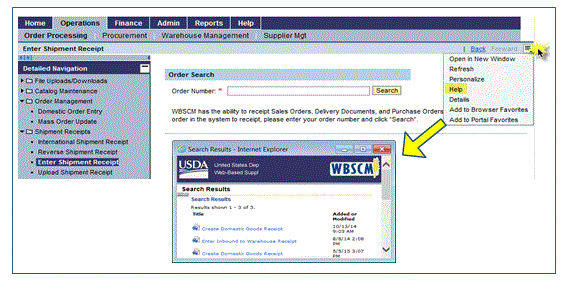
WBSCM Annual User Validation Reminder
At the end
of August, USDA issued an email reminder to all WBSCM users regarding the
annual validation requirement. This process ensures that only active user
profiles are retained in the system. Per
USDA policy, inactive user profiles are locked after nine months and deleted
after twelve months.
All Users: If you have not accessed the system within
the previous nine months (or are unsure of the date of your last login) and
want to remain active, please login to the WBSCM
Production Portal immediately to avoid deletion. If needed, self-service
tools are available to recover your User
ID or Password
from the eAuthentication system.
User
Administrators: Confirm that users
in your organization(s) are active and have been assigned the appropriate roles
and update the user profile as appropriate. (Work Instruction is available at Help tab -> Training Materials -> Work
instructions -> External
-> Fulfillment (WI-Ext) -> Domestic -> Display and Maintain User.) To assist you with these tasks, the User Security Report has been
enhanced; this report now provides an option to run a consolidated report of
users from the parent organization (e.g., SDA) and sub organizations (e.g., RAs
or Co-Ops). When performing annual user validation, it may also be helpful to
use the Last Activity Date selection criteria to identify inactive users that
need to be locked or deleted. (Job Aid is available at Help tab -> Training
Materials -> Job Aids -> Reports (JA) -> User Security Report.)

USDA staff will be participating in these upcoming meetings in 2016 and 2017. We look forward to the opportunity to meet you and hope to see you there!
October 31-November 3: 2016 USDA/State Agency Meeting for Child Nutrition Programs in Arlington, Virginia
November 9-10: School Nutrition Association (SNA) Fall Industry Boot Camp in National Harbor, Maryland
December 6-8: School Food Focus National Gathering in Braselton, Georgia
January 22-24: SNA School Nutrition Industry Conference in Orlando, Florida
March 5-7: Food Research and Action Center and Feeding America National Anti-Hunger Policy
Conference in Washington, DC
March 12-14: National Commodity Supplemental Food Program Association (NCSFPA) Annual Conference in New Orleans, Louisiana
April 2-4: SNA Legislative Action Conference in Washington, DC
April 23-26: American Commodity Distribution Association (ACDA) Annual Conference in Denver, Colorado
June 12-16: National Association of Food Distribution Programs on Indian Reservations (NAFDPIR) Conference in St. Louis, Missouri
July 9-12: SNA Annual National Conference in Atlanta, Georgia
 Here's how to sign up for these updates via GovDelivery:
1. Go to the Food Distribution website.
2. Click on the red envelope on the row of social media icons on the top right of the page.
3. Enter your email address and click "Submit."
4. Check the boxes to select your topics of interest. For these e-letters, scroll down to the Food Distribution category and click the plus sign to the left of the check box to expand the list and view all the sub-categories. Check these sub-categories to receive the corresponding e-letters:
*USDA Foods --> receive all "USDA Foods from Farm to Plate" general + program-specific e-letters
*Commodity Supplemental Food Program (CSFP) --> receive "Household Highlights" e-letter
*The Emergency Food Assistance Program (TEFAP) --> receive "Household Highlights" e-letter
*Food Distribution Program on Indian Reservations (FDPIR) --> receive "FDPIR Connection" e-letter
*Schools/Child Nutrition Commodity Programs --> receive "Spotlight on Schools" e-letter
5. Update your subscription preferences any time by following the above steps or clicking on the Subscriber Preferences Page link at the bottom of any of the e-letter email messages you receive from GovDelivery. Questions? Contact us at USDAFoods@fns.usda.gov
|
|